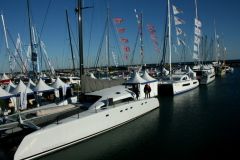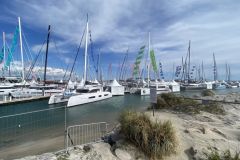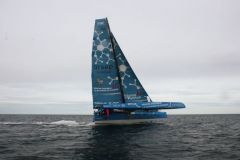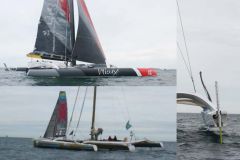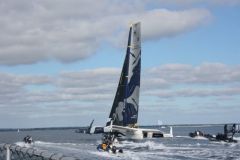There were 5 of them aboard the Maserati Multi 70, attempting to beat the Tea Route Record, previously held by Gitana 13, the 100 foot maxi catamaran led by Lionel Lemonchois, who in 2008 had completed the course in just under 42 days. Setting out on 18 January from Hong Kong, Giovanni Soldini and the crew of the Italian trimaran made up of Guido Broggi, Sébastien Audigane, Oliver Herrera Perez and Alex Pella crossed the finish line of the Tea Route by passing under the Queen Elizabeth II Bridge on their way to London.
The trimaran will therefore have taken 36 days, 2 hours, 37 minutes and 2 seconds to cover the 13,000 nautical miles of the theoretical route between the Chinese port and the capital of the United Kingdom. In reality, the Multi 70 has covered 15,083 nautical miles at an average speed of 17.4 knots. Here is a summary of the route followed.
Gybes in the China Sea
For the first two days, the crew took advantage of the northeast winds to perform a series of gybes, getting closer to the southern tip of Vietnam. On the third day, off Singapore, a first transition with little wind was negotiated. On the fourth and fifth day, the crew sailed in light breezes to pass the Sound Sound strait and enter the Indian Ocean with a two-day advantage over Gitana 13.
Deep in the Indian Ocean after all
Day 6 marks the entry of the Maserati Multi 70 into the Indian Ocean, and the crossing of a tropical depression located in the south-west of Sumatra. From the seventh to the ninth day, Maserati Multi 70 is sailing downwind at high speed on the direct route in the SE'ly trade winds of the southern hemisphere, recording the best day's sailing with 644 miles covered in 24 hours.
On the 10th day, the crew broke the rudder of the starboard float as a result of a collision with a floating object, before it was repaired on the 11th day. The advantage of the Maserati Multi 70 reached its minimum when it passed below 250 miles. On the twelfth day, the route leaves the trade wind zone and passes a high-pressure pass.
The next three days are characterized by the passage of three cold fronts. Maserati Multi 70 reaches the southernmost latitudes of its journey, around 38°S. The Cape of Good Hope is rounded on the sixteenth day, five days ahead of Gitana 13.
The South Atlantic on the African side
The Maserati Multi 70 is starting its ascent of the South Atlantic downwind. On the 19th day, the team chose the eastern option to cross the Equator. From day 20 to day 23, the Maserati Multi 70 heads towards West Africa following the direct route and crosses off the Gulf of Guinea, before crossing the Equator on day 22. Maserati's advantage reaches its maximum with 2,046 miles.
An unusual trajectory in the North Atlantic
On the 23rd day, the Maserati Multi 70 is slowed down in Sierra Leone by an unexpected light wind bubble. The crew still has to cross the doldrums and a stationary tropical depression close to the coast. The situation of the Azores High remains atypical, it is impossible to avoid it by going west, the eastern option continues.
From the twenty-fifth to the thirtieth day, the Maserati Multi 70 makes several tacks along the coast of West Africa as far as the Canary Islands. The advantage remains stable at around 1,200 miles. On the thirty-first day, upwind sailing begins against the NE winds, Maserati Multi 70 gets closer to the Portuguese coast. The second part of the crossing of the Bay of Biscay is very fast.
The English Channel upwind and the Thames downwind
Maserati Multi 70 enters the English Channel before dawn on 22nd February. It begins its thirty-fifth day of sailing between British Cornwall and Brittany and continues its course towards the southern coast of England, before resuming the sequence of tacking close to the coast in freezing cold. The following day, early in the morning, the trimaran entered the Pas de Calais, rounded the south-east end of England to go up the Thames estuary, then the river as far as the Queen Elizabeth II bridge. The line is crossed on 23 February at 13.30 UTC.


